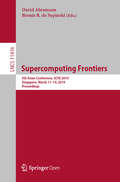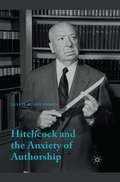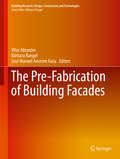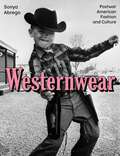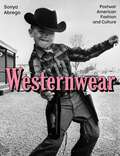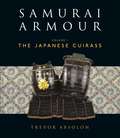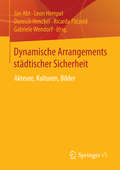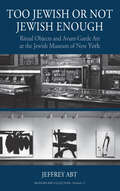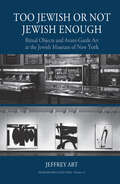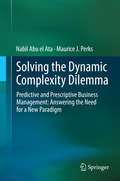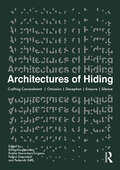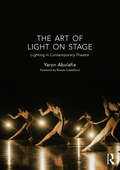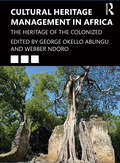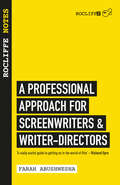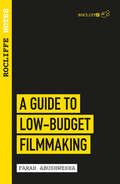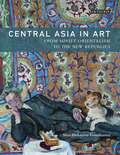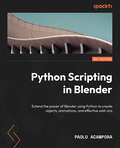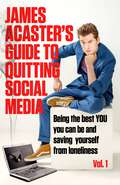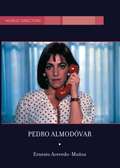- Table View
- List View
Supercomputing Frontiers: 5th Asian Conference, SCFA 2019, Singapore, March 11–14, 2019, Proceedings (Lecture Notes in Computer Science #11416)
by David Abramson Bronis R. de SupinskiThis open access book constitutes the refereed proceedings of the 5th Asian Supercomputing Conference, SCFA 2019, held in Singapore in March 2019. The 6 full papers presented in this book were carefully reviewed and selected from 33 submissions. They cover a range of topics including memory fault handling, linear algebra, image processing, heterogeneous computing, resource usage prediction, and data caching.
Hitchcock & the Anxiety of Authorship
by Leslie H. AbramsonHitchcock and the Anxiety of Authorship examines issues of cinema authorship engaged by and dynamized within the director's films. A unique study of self-reflexivity in Hitchcock's work from his earliest English silents to his final Hollywood features, this book considers how the director's releases constitute ever-shifting meditations on the conditions and struggles of creative agency in cinema. Abramson explores how, located in literal and emblematic sites of dramatic production, exhibition, and reception, and populated by figures of directors, actors, and audiences, Hitchcock's films exhibit a complicated, often disturbing vision of authorship - one that consistently problematizes rather than exemplifies the director's longstanding auteurist image. Viewing Hitchcock in a striking new light, Abramson analyzes these allegories of vexed agency in the context of his concepts of and commentary on the troubled association between cinema artistry and authorship, as well as the changing cultural, industrial, theoretical, and historical milieus in which his features were produced. Accordingly, the book illuminates how Hitchcock and his cinema register the constant dynamics that constitute film authorship.
The Pre-Fabrication of Building Facades (Building Research: Design, Construction and Technologies)
by Vitor Abrantes Bárbara Rangel José Manuel Amorim FariaThis book compares two buildings with different technologies and distinct environment from the combined viewpoints of civil engineering and architecture. The first is the most recent building of Columbia University in New York, the Northwest Science Building, a project designed by Rafael Moneo and Dan Brodkin of Ove Arup. The second one is the Burgo Tower in Oporto, by Eduardo Souto Moura and Rui Furtado of AFA, a building that brings a new perspective to the use of prefabrication technologies with local traditional construction systems. With the detailed analyses of recognized researchers in civil engineering and architecture, this book is a reflection upon the problems and solutions in the design and construction process of a prefabricated building system. This volume, like those to follow, brings together, building research and building design practice to enhance the knowledge of complementarity areas involved in construction, engineering and architecture. This is the first book in a new series "Building Research: Design, Construction and Technologies" which aims to bridge scientific research and professional practice to understand the Building Design problems. In each edition, one or two case studies (recognized buildings in the international design panorama) are analyzed with their authors to assess the design process and the construction development. To understand the problems involved, researchers, engineers and architects, are asked to contribute to this analysis with essays on building research issues, as building technology, construction management, acoustics, maintenance or prefabrication.
Westernwear: Postwar American Fashion and Culture
by Sonya AbregoDuring the prosperous, forward-thinking era after the Second World War, a growing number of men, women, and children across the United States were wearing fashions that evoked the Old West. Westernwear: Postwar American Fashion and Culture examines why a sartorial style with origins in 19th-century agrarian traditions continued to be worn at a time when American culture sought balance between technocratic confidence in science and technology on one side, and fear and anxiety over global annihilation on the other. By analysing well-known and rarely considered western manufacturers, Westernwear revises the common perception that fashionable innovation came from the East coast and places western youth cultures squarely back in the picture. The book connects the history of American working class dress with broader fashionable trends and discusses how and why Native American designs and representations of Native American people were incorporated broadly and inconsistently into the western visual vocabulary. Setting westernwear firmly in context, Sonya Abrego addresses the incorporation of this iconic style into postwar wardrobes and popular culture, and charts the evolution of westernwear into a modern fashion phenomenon.
Westernwear: Postwar American Fashion and Culture
by Sonya AbregoDuring the prosperous, forward-thinking era after the Second World War, a growing number of men, women, and children across the United States were wearing fashions that evoked the Old West. Westernwear: Postwar American Fashion and Culture examines why a sartorial style with origins in 19th-century agrarian traditions continued to be worn at a time when American culture sought balance between technocratic confidence in science and technology on one side, and fear and anxiety over global annihilation on the other. By analysing well-known and rarely considered western manufacturers, Westernwear revises the common perception that fashionable innovation came from the East coast and places western youth cultures squarely back in the picture. The book connects the history of American working class dress with broader fashionable trends and discusses how and why Native American designs and representations of Native American people were incorporated broadly and inconsistently into the western visual vocabulary. Setting westernwear firmly in context, Sonya Abrego addresses the incorporation of this iconic style into postwar wardrobes and popular culture, and charts the evolution of westernwear into a modern fashion phenomenon.
Samurai Armour: Volume I: The Japanese Cuirass
by Trevor AbsolonFor beauty, precision and strength, nothing has ever matched the combination of form and function found in the armour of the samurai. For a samurai, the consummate warrior, his suit of armour was so much more than 'just' protective equipment that could save his life in the heat of battle – it was the embodiment of his personality, social status and very soul. This volume, the first in a two-part series on the armour of the samurai, traces first the history of the samurai themselves and then examines the history and evolution of the cuirass or dou, the armour protecting the samurai's chest. Drawing on over 20 years of research and technical work by Trevor Absolon, a leading expert, this is a complete study of this fundamental aspect of samurai armour construction. Illustrated throughout with photographs and diagrams, this is more than just a detailed technical exploration, it is a meditation on a process that was, and still is, nothing short of an art form.
Samurai Armour: Volume I: The Japanese Cuirass
by Trevor AbsolonFor beauty, precision and strength, nothing has ever matched the combination of form and function found in the armour of the samurai. For a samurai, the consummate warrior, his suit of armour was so much more than 'just' protective equipment that could save his life in the heat of battle – it was the embodiment of his personality, social status and very soul. This volume, the first in a two-part series on the armour of the samurai, traces first the history of the samurai themselves and then examines the history and evolution of the cuirass or dou, the armour protecting the samurai's chest. Drawing on over 20 years of research and technical work by Trevor Absolon, a leading expert, this is a complete study of this fundamental aspect of samurai armour construction. Illustrated throughout with photographs and diagrams, this is more than just a detailed technical exploration, it is a meditation on a process that was, and still is, nothing short of an art form.
Dynamische Arrangements städtischer Sicherheit: Akteure, Kulturen, Bilder
by Jan Abt Leon Hempel Dietrich Henckel Ricarda Pätzold Gabriele WendorfDer Befund einer Pluralisierung der Sicherheitsproduktion und Allgegenwärtigkeit von „Sicherheit“ in der Diskussion um Stadt kann darauf zurück geführt werden, dass die Akteure, deren Verbindungen untereinander, ihre Aufgaben und Techniken weniger eindeutig als in der Vergangenheit fixiert sind. Anspruch des vorliegenden Bandes – an der Schnittstelle zwischen sozialer und räumlich orientierter Sicherheitsforschung – ist es, die lokal vielfältigen Formen der Sicherheitsproduktion zu illustrieren und die Konflikte, Widersprüche und Folgen für das Leben in den Städten sowie das Handlungsfeld urbane Sicherheit aufzuzeigen. Sicherheit wird damit im Spannungsfeld der Materialität des urbanen Raums und übergeordneter kulturell tradierter Deutungsmuster thematisiert.
Too Jewish or Not Jewish Enough: Ritual Objects and Avant-Garde Art at the Jewish Museum of New York (Museums and Collections #17)
by Jeffrey AbtDisplays of Jewish ritual objects in public, non-Jewish settings by Jews are a comparatively recent phenomenon. So too is the establishment of Jewish museums. This volume explores the origins of the Jewish Museum of New York and its evolution from collecting and displaying Jewish ritual objects, to Jewish art, to exhibiting avant-garde art devoid of Jewish content, created by non-Jews. Established within a rabbinic seminary, the museum’s formation and development reflect changes in Jewish society over the twentieth century as it grappled with choices between religion and secularism, particularism and universalism, and ethnic pride and assimilation.
Too Jewish or Not Jewish Enough: Ritual Objects and Avant-Garde Art at the Jewish Museum of New York (Museums and Collections #17)
by Jeffrey AbtDisplays of Jewish ritual objects in public, non-Jewish settings by Jews are a comparatively recent phenomenon. So too is the establishment of Jewish museums. This volume explores the origins of the Jewish Museum of New York and its evolution from collecting and displaying Jewish ritual objects, to Jewish art, to exhibiting avant-garde art devoid of Jewish content, created by non-Jews. Established within a rabbinic seminary, the museum’s formation and development reflect changes in Jewish society over the twentieth century as it grappled with choices between religion and secularism, particularism and universalism, and ethnic pride and assimilation.
Too Jewish or Not Jewish Enough: Ritual Objects and Avant-Garde Art at the Jewish Museum of New York (Museums and Collections #17)
by Jeffrey AbtDisplays of Jewish ritual objects in public, non-Jewish settings by Jews are a comparatively recent phenomenon. So too is the establishment of Jewish museums. This volume explores the origins of the Jewish Museum of New York and its evolution from collecting and displaying Jewish ritual objects, to Jewish art, to exhibiting avant-garde art devoid of Jewish content, created by non-Jews. Established within a rabbinic seminary, the museum’s formation and development reflect changes in Jewish society over the twentieth century as it grappled with choices between religion and secularism, particularism and universalism, and ethnic pride and assimilation.
Solving the Dynamic Complexity Dilemma: Predictive and Prescriptive Business Management: Answering the Need for a New Paradigm
by Nabil Abu el Ata Maurice J. PerksDynamic complexity results from hidden, unknown factors—or more precisely, interactions between factors—that can unexpectedly impact the performance of systems. When the influences of dynamic complexity are not measured and understood, new never-seen-before behaviors can come as unwelcomed surprises, which disrupt the performance of systems. Left alone, processes that were once prized for their efficiency unexpectedly begin to degrade—costs increase, while volumes and quality decline. Evidence of problems may come too late for effective resolution as technology advancements induce rapid change and compress the time available to react to that change. The results of dynamic complexity are always negative and unmanaged dynamic complexity can bring business or global systems to the point of sudden chaos. The 2009 H1N1 pandemic, 2008 Credit Crunch and 2011 Fukushima Daiichi nuclear disaster are global examples of the dangers of undiagnosed dynamic complexity.With increasing frequency executive leaders today are discovering that their business and IT system performance levels are not meeting expectations. In most cases these performance deficiencies are caused by dynamic complexity, which lies hidden like a cancer until the symptoms reveal themselves—often when it is too late to avoid negative impacts on business outcomes. This book examines the growing business problem of dynamic complexity and presents a path to a practical solution. To achieve better predictability, organizations must be able to expose new, dangerous patterns of behavior in time to take corrective actions and know which actions will yield the optimal results. The book authors promote new methods of risk management that use data collection, analytics, machine learning and automation processes to help organizations more accurately predict the future and take strategic actions to improve performance outcomes. The presented means of achieving this goal are based upon the authors’ practical experiences, backed by scientific principles, and results achieved through consulting engagements with over 350 global organizations.
Architectures of Hiding: Crafting Concealment | Omission | Deception | Erasure | Silence
by Rana Abughannam Émélie Desrochers-Turgeon Pallavi Swaranjali Federica GoffiArchitecture manifests as a space of concealment and unconcealment, lethe and alêtheia, enclosure and disclosure, where its making and agency are both hidden and revealed. With an urgency to amplify narratives that are overlooked, silenced and unacknowledged in and by architectural spaces, histories and theories, this book contends the need for a critical study of hiding in the context of architectural processes. It urges the understanding of inherent opportunities, power structures and covert strategies, whether socio-cultural, geo-political, environmental or economic, as they are related to their hidescapes – the constructed landscapes of our built environments participating in the architectures of hiding. Looking at and beyond the intentions and agency that architects possess, architectural spaces lend themselves as apparatuses for various forms of hiding and un(hiding). The examples explored in this book and the creative works presented in the interviews enclosed in the interludes of this publication cover a broad range of geographic and cultural contexts, discursively disclosing hidden aspects of architectural meaning. The book investigates the imaginative intrigue of concealing and revealing in design processes, along with moral responsibilities and ethical dilemmas inherent in crafting concealment through the making and reception of architecture.
The Art of Light on Stage: Lighting in Contemporary Theatre
by Yaron AbulafiaThe Art of Light on Stage is the first history of theatre lighting design to bring the story right up to date. In this extraordinary volume, award-winning designer Yaron Abulafia explores the poetics of light, charting the evolution of lighting design against the background of contemporary performance. The book looks at the material and the conceptual; the technological and the transcendental. Never before has theatre design been so vividly and excitingly illuminated. ? The book examines the evolution of lighting design in contemporary theatre through an exploration of two fundamental issues: ? 1.?????? What gave rise to the new directions in lighting design in contemporary theatre? 2.?????? How can these new directions be viewed within the context of lighting design history? ? The study then focuses on the phenomenological and semiotic aspects of the medium for light – the role of light as a performer, as the medium of visual perception and as a stimulus for imaginative representations – in selected contemporary theatre productions by Robert Wilson, Romeo Castellucci, Heiner Goebbels, Jossi Wieler and David Zinder. ? This ground-breaking book will be required reading for anyone concerned with the future of performance.
The Art of Light on Stage: Lighting in Contemporary Theatre
by Yaron AbulafiaThe Art of Light on Stage is the first history of theatre lighting design to bring the story right up to date. In this extraordinary volume, award-winning designer Yaron Abulafia explores the poetics of light, charting the evolution of lighting design against the background of contemporary performance. The book looks at the material and the conceptual; the technological and the transcendental. Never before has theatre design been so vividly and excitingly illuminated. ? The book examines the evolution of lighting design in contemporary theatre through an exploration of two fundamental issues: ? 1.?????? What gave rise to the new directions in lighting design in contemporary theatre? 2.?????? How can these new directions be viewed within the context of lighting design history? ? The study then focuses on the phenomenological and semiotic aspects of the medium for light – the role of light as a performer, as the medium of visual perception and as a stimulus for imaginative representations – in selected contemporary theatre productions by Robert Wilson, Romeo Castellucci, Heiner Goebbels, Jossi Wieler and David Zinder. ? This ground-breaking book will be required reading for anyone concerned with the future of performance.
Cultural Heritage Management in Africa: The Heritage of the Colonized
by George Okello Abungu Webber NdoroCultural Heritage Management in Africa explores the diversity of Africa’s cultural heritage by analysing how and why this heritage has been managed, and by considering the factors that continue to influence management strategies and systems throughout the African continent. Including contributions from prominent scholars and heritage professionals working across Africa, the volume presents critical, contemporary perspectives on the state of heritage in the area. Chapters analyse the practices that emanated from different colonial experiences and consider what impact these had – and continue to have – on the management of African heritage. It also critically examines the ideological influence of independence movements on the African continent’s management and remembering of heritage, and considers whether there are any differences in heritage management between countries that experienced armed conflicts and those that did not. The volume will be the first to critically assess the state of heritage management now, at a time when vital conversations about the balance between heritage and development is ongoing and the actions of new players have begun to impact the management and practice of heritage in the region. Cultural Heritage Management in Africa will be essential reading for those engaged in the study of museums and heritage, development, archaeology, anthropology, history and African studies. It will also be of interest to heritage and museum professionals who wish to learn more about the decolonisation of heritage.
Cultural Heritage Management in Africa: The Heritage of the Colonized
by George Okello Abungu Webber NdoroCultural Heritage Management in Africa explores the diversity of Africa’s cultural heritage by analysing how and why this heritage has been managed, and by considering the factors that continue to influence management strategies and systems throughout the African continent. Including contributions from prominent scholars and heritage professionals working across Africa, the volume presents critical, contemporary perspectives on the state of heritage in the area. Chapters analyse the practices that emanated from different colonial experiences and consider what impact these had – and continue to have – on the management of African heritage. It also critically examines the ideological influence of independence movements on the African continent’s management and remembering of heritage, and considers whether there are any differences in heritage management between countries that experienced armed conflicts and those that did not. The volume will be the first to critically assess the state of heritage management now, at a time when vital conversations about the balance between heritage and development is ongoing and the actions of new players have begun to impact the management and practice of heritage in the region. Cultural Heritage Management in Africa will be essential reading for those engaged in the study of museums and heritage, development, archaeology, anthropology, history and African studies. It will also be of interest to heritage and museum professionals who wish to learn more about the decolonisation of heritage.
Rocliffe Notes: A Professional Approach For Screenwriters and Writer-Directors (Rocliffe Notes)
by Farah AbushweshaRocliffe Notes is a compendium for screenwriters and filmmakers which brings together tips and opinions from over 140 film and TV industry professionals, and provides a step-by-step, common-sense guide on how writers and writer-directors can best present themselves to the industry.Including insider insights from award-winning industry players, it details their habits, writing processes, daily passions and preoccupations, whilst also looking at the nuts and bolts of the industry, aiming to motivate writers on their own creative journey, maximise networking opportunities and encourage a professional approach to writing.An essential armament in any writer's store, contributors include: Moira Buffini, Danny Huston, David Parfitt, Jack Thorne, Sarah Gavron, John Madden, John Yorke, Nik Powell, Peter Kosminsky, Christine Langan and Asif Kapadia.'A really useful guide to getting on in the world of film' - Richard Eye'An indispensable addition to the writer's bookshelf' - Lock and load, brides of ChristLook out for the second book in the series: Rocliffe Notes: A Guide to Low Budget Filmmaking.
Rocliffe Notes - A Guide to Low Budget Filmmaking: Taking Your Film from Script to Screen (Rocliffe Notes)
by Farah AbushweshaThe second book in the Rocliffe Notes series, A Guide to Low-Budget Filmmaking is a practical, step-by-step guide to getting your film made, taking it all the way from a script to the screen. It covers every aspect of the process, including: budgeting and finance; casting, crewing and scheduling; shooting and post-production; and marketing and festival strategy. It also incorporates unique insights and insider confidences from peers and established industry players - from directors, writers and producers, through to sales and marketing consultants and distributors. Contributors include: Sean Baker, Saul Dibb, Destiny Ekaragha, Camille Gatin, Sarah Gavron, Shirley Henderson, John Madden, Maxine Peake and Asif Kapadia.A revelation for all would-be filmmakers, it's the essential guide to the nuts-and-bolts of making a film, and a must-have for anyone thinking of making a film on one of the low-budget Microwave, iFeatures or Catalyst schemes, whose recent critical and box-office successes include Lady Macbeth, God's Own Country and The Levelling.'A really useful guide to getting on in the world of film' - Richard Eyre, Writer & Director'This is the book I wish I had when I was started out working in the movies. Would that it had existed a few decades ago. It's detailed, optimistic and full of practical and useful information' - John Malkovich, Actor, Writer & Producer'An insightful and crystal clear read for anyone wanting to produce their first film be it a short or a feature' - Fodhla Cronin O'Reilly, ProducerLook out for the other book in the series: Rocliffe Notes - A Professional Approach for Screenwriters and Writer-Directors.
Central Asia in Art: From Soviet Orientalism to the New Republics
by Aliya Abykayeva-TiesenhausenIn the midst of the space race and nuclear age, Soviet Realist artists were producing figurative oil paintings. Why? How was art produced to control and co-opt the peripheries of the Soviet Union, particularly Central Asia? Presenting the 'untold story' of Soviet Orientalism, Aliya Abykayeva-Tiesenhausen re-evaluates the imperial project of the Soviet state, placing the Orientalist undercurrent found within art and propaganda production in the USSR alongside the creation of new art forms in Kazakhstan, Kyrgyzstan and Uzbekistan. From the turmoil of the 1930s through to the post-Stalinist era, the author draws on meticulous new research and rich illustrations to examine the political and social structures in the Soviet Union - and particularly Soviet Central Asia - to establish vital connections between Socialist Realist visual art, the creation of Soviet identity and later nationalist sentiments.
Python Scripting in Blender: Extend The Power Of Blender Using Python To Create Objects, Animations, And Effective Add-ons
by Paolo AcamporaExtend the power of Blender using Python to create objects, animations, and effective add-ons
Python Scripting In Blender: Extend The Power Of Blender Using Python To Create Objects, Animations, And Effective Add-ons
by Paolo AcamporaJames Acaster's Guide to Quitting Social Media
by James AcasterThis is a self-help book like no other. Because you are not helping yourself, James Acaster is helping you.In 2019, James quit all forms of social media - covering his phone in tar and driving it to a lock-up in Rhyl, before setting up home in a castle he'd built himself called Castle Anti-Net. But when the withdrawal symptoms hit him, he realised in order to stay clean he'd have to replace everything social media gave him with three-dimensional, real-life activities. Employing the help of a mysterious, wealthy benefactor named Clancy Dellahue, and an ever-growing gang of misfits (aka the Tangfastic Crew), James found ways to replace his online friends (he joined the scouts) and spy on his exes (climbing ropes, zip lines, fake moustache) as well as anonymously bullying strangers, seeing photos of everyone's dogs, getting public figures fired, arguing with everybody about everything, and so much more. His life is amazing and yours could be too if you buy JAMES ACASTER'S GUIDE TO QUITTING SOCIAL MEDIA, BEING THE BEST YOU YOU CAN BE AND SAVING YOURSELF FROM LONELINESS VOL. 1.
Art becomes Architecture becomes Art: A Conversation between Vito Acconci and Kenny Schachter, moderated by Lilian Pfaff (Kunst und Architektur im Gespräch Art and Architecture in Discussion)
by Vito Acconci Kenny Schachter Lilian PfaffBekannt als Konzept- und Performance-Künstler, der seiner Zeit weit voraus war, verwirklichte Vito Acconci 2003 eines seiner ersten architektonischen Projekte. Für seinen Galeristen-Freund Kenny Schachter gestaltete er den multifunktionalen Galerieraum conTEMPorary in New York. Dieser "experimentelle Raum" wurde Programm für ihre weitere Zusammenarbeit bis hin zum neuesten gemeinsamen Projekt in King’s Cross, London. Vito Acconci wurde über die Jahre mehr und mehr zum Architekten. Sein Acconci Studio plant so unterschiedliche Projekte wie den Skateboard Park in San Juan, den Inside-Out Bookstore (Documenta X) oder städtebauliche Planungen für Tel Aviv. Vito Acconci und Kenny Schachter trafen sich 2004 und 2005 zu zwei Gesprächen in London und Basel.
Pedro Almodovar (World Directors)
by Ernesto R. Acevedo-MunozThe book provides a detailed introduction to the essential themes, style, and aesthetics of Pedro Almodovar's films, put in the context of Spain's profound cultural transitions since 1980. With precise and close analysis, the book covers the major concerns of the most successful of all Spanish film directors and makes direct, clear connections to the logic of Almodovar's aesthetic and stylistic choices. By spanning the entirety of Pedro Almodovar's feature making career, the book emphasizes the director's sensibility to make the outrageous believable and to always give a unique spin to the issues Spanish history, culture and identity. A detailed and comprehensive approach to all of Pedro Almodovar's feature films from the outrageous 1980 'Pepi, Luci, Bom and Other Girls on the Heap' to the sophisticated 2004 'Bad Education', this book provides more than an introduction an intimate look at the topics, style, aesthetics and cultural sensibilities of Spain's most distinguished and celebrated film director since Luis Bunuel. By focusing on a film-by-film, and often scene-by-scene analysis, this book offers a meticulous interpretation of characters, situations, allusions and cultural intersections, as well as emphasizing the meaning and weight of cultural, historical and social contexts. The book traces the evolution of Almodovar's career, from the perspective of aesthetic, narrative and stylistic concerns and places those changes in the logical context of Spain's historical trajectory from the end of Franco's dictatorship to the transition to democracy, exploring Almodovar's interest on issues of identity, sexuality, and nationalism.
